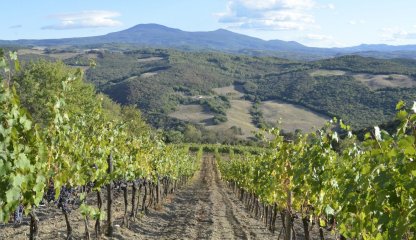Orcia DOC
A wine that represents the authentic soul of the Val d’Orcia
From the hills between Montalcino and Montepulciano comes Orcia DOC, a wine that expresses all the beauty and harmony of a landscape declared a UNESCO World Heritage Site.
The Orcia DOC appellation was founded on February 14, 2000, thanks to the tenacity of some of the founding producers of the Orcia Wine Consortium, with the aim of protecting and promoting the image of the wine and its territory.
12 municipalities are included in the designation: Buonconvento, Castiglione d’Orcia, Pienza, Radicofani, San Quirico d’Orcia and Trequanda, as well as parts of the territories of Abbadia San Salvatore, Chianciano Terme, Montalcino, San Casciano dei Bagni, Sarteano and Torrita di Siena.
Grapevine
Under the Orcia DOC appellation, the protagonist is Sangiovese, which must comprise at least 60% of the blend, flanked by other authorized non-aromatic varieties.
The wine can be sold from March 1 of the year following harvest.
The Orcia Riserva version is distinguished by a longer aging period of at least 24 months, 12 of which are in wooden barrels to help confer greater complexity, elegance and aromatic depth.
Orcia Sangiovese further elevates the character of this grape, with at least 90% Sangiovese supplemented by minor quotas of indigenous grapes such as Canaiolo Nero, Colorino, Ciliegiolo, Foglia Tonda, Pugnitello and Malvasia Nera.
The Orcia Sangiovese Riserva, aged for no less than 30 months, 24 of which are in wood, expresses an important structure and a refined bouquet.
Orcia Rosato is also made from Sangiovese (minimum 60%) and distinguished by its fresh and fragrant aromas, while Orcia Bianco is made from Trebbiano Toscano (minimum 50%) along with other non-aromatic varieties, offering a harmonious and bright drink. Both versions can be sold as of March 1 of the year following harvest.
Concluding the range is Orcia Vin Santo made from Trebbiano Toscano and Malvasia Bianca Lunga, alone or jointly but at least 50%, along with other non-aromatic grapes.
After careful selection, the grapes are allowed to dry naturally to concentrate into a high sugar content.
Vinification and aging take place in traditional wooden kegs for at least 18 months, with release for consumption no earlier than November 1 of the third year following harvest.
The result is a special, velvety wine that encompasses all the sweetness and warmth of the Orcia region.
Under the Orcia DOC appellation, the protagonist is Sangiovese, which must comprise at least 60% of the blend, flanked by other authorized non-aromatic varieties.
The wine can be sold from March 1 of the year following harvest.
The Orcia Riserva version is distinguished by a longer aging period of at least 24 months, 12 of which are in wooden barrels to help confer greater complexity, elegance and aromatic depth.
Orcia Sangiovese further elevates the character of this grape, with at least 90% Sangiovese supplemented by minor quotas of indigenous grapes such as Canaiolo Nero, Colorino, Ciliegiolo, Foglia Tonda, Pugnitello and Malvasia Nera.
The Orcia Sangiovese Riserva, aged for no less than 30 months, 24 of which are in wood, expresses an important structure and a refined bouquet.
Orcia Rosato is also made from Sangiovese (minimum 60%) and distinguished by its fresh and fragrant aromas, while Orcia Bianco is made from Trebbiano Toscano (minimum 50%) along with other non-aromatic varieties, offering a harmonious and bright drink. Both versions can be sold as of March 1 of the year following harvest.
Concluding the range is Orcia Vin Santo made from Trebbiano Toscano and Malvasia Bianca Lunga, alone or jointly but at least 50%, along with other non-aromatic grapes.
After careful selection, the grapes are allowed to dry naturally to concentrate into a high sugar content.
Vinification and aging take place in traditional wooden kegs for at least 18 months, with release for consumption no earlier than November 1 of the third year following harvest.
The result is a special, velvety wine that encompasses all the sweetness and warmth of the Orcia region.
Characteristics
Orcia DOC wines are distinguished by their great elegance and deep connection with the territory from which they come.
The color varies from deep ruby red, typical of the young versions, to garnet shades in the reserves, which have complex and persistent aromas.
Fruity and spicy notes emerge on the nose, while the palate proves to be harmonious, structured and with good longevity.
The white versions are characterized by freshness and aromatic finesse, with floral and fruity hints, while the rosés offer a balanced and fragrant taste.
Vin Santo Orcia, rather, is amber-gold in color, with intense aromas and a velvety, lingering flavor.
Orcia DOC wines are distinguished by their great elegance and deep connection with the territory from which they come.
The color varies from deep ruby red, typical of the young versions, to garnet shades in the reserves, which have complex and persistent aromas.
Fruity and spicy notes emerge on the nose, while the palate proves to be harmonious, structured and with good longevity.
The white versions are characterized by freshness and aromatic finesse, with floral and fruity hints, while the rosés offer a balanced and fragrant taste.
Vin Santo Orcia, rather, is amber-gold in color, with intense aromas and a velvety, lingering flavor.
Gastronomy
Orcia DOC pairs perfectly with traditional Tuscan cuisine—cured meats and aged cheeses, pasta dishes with meat sauce, game and grilled red meat.
The white and rosé versions are ideal with appetizers, vegetable soups and fish dishes, while the Vin Santo elegantly accompanies flaky pastries, cookies and classic cantucci (biscotti).
Orcia DOC pairs perfectly with traditional Tuscan cuisine—cured meats and aged cheeses, pasta dishes with meat sauce, game and grilled red meat.
The white and rosé versions are ideal with appetizers, vegetable soups and fish dishes, while the Vin Santo elegantly accompanies flaky pastries, cookies and classic cantucci (biscotti).





